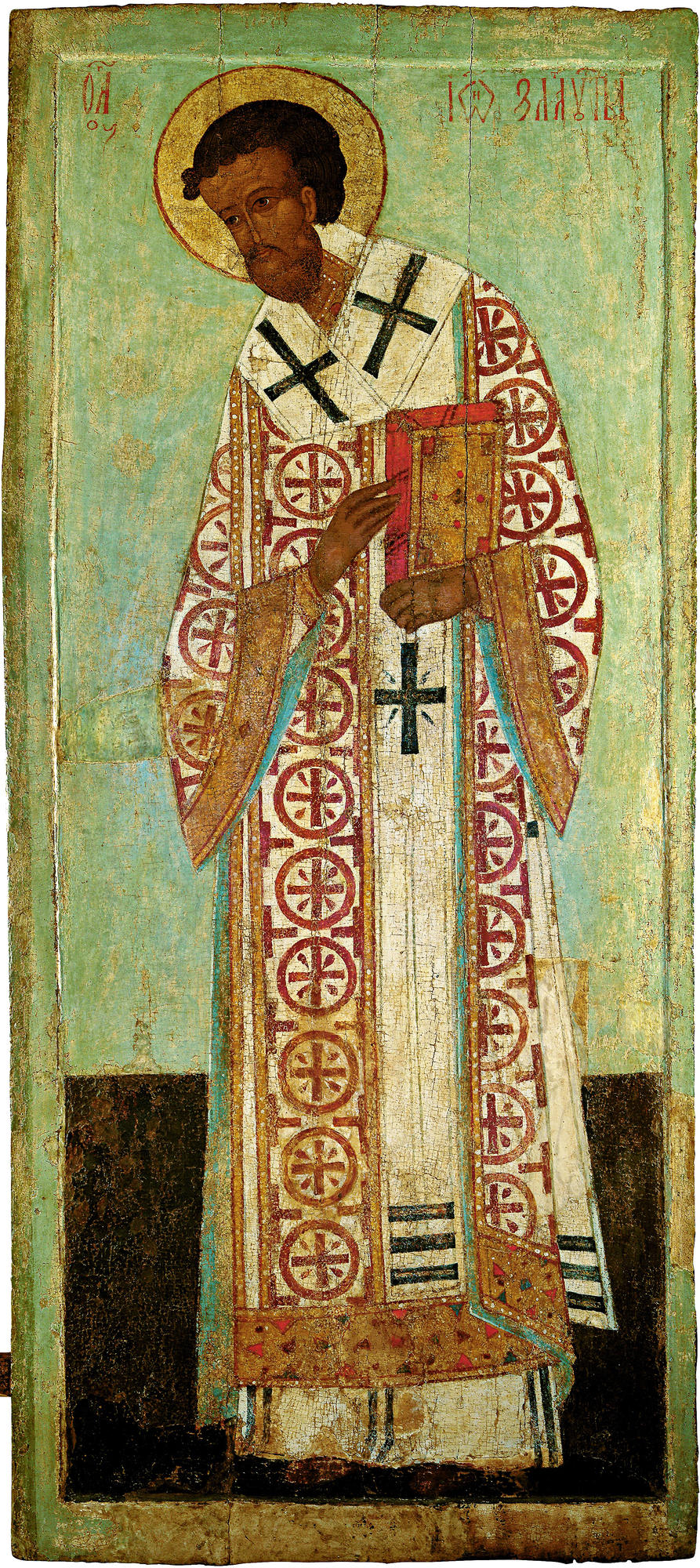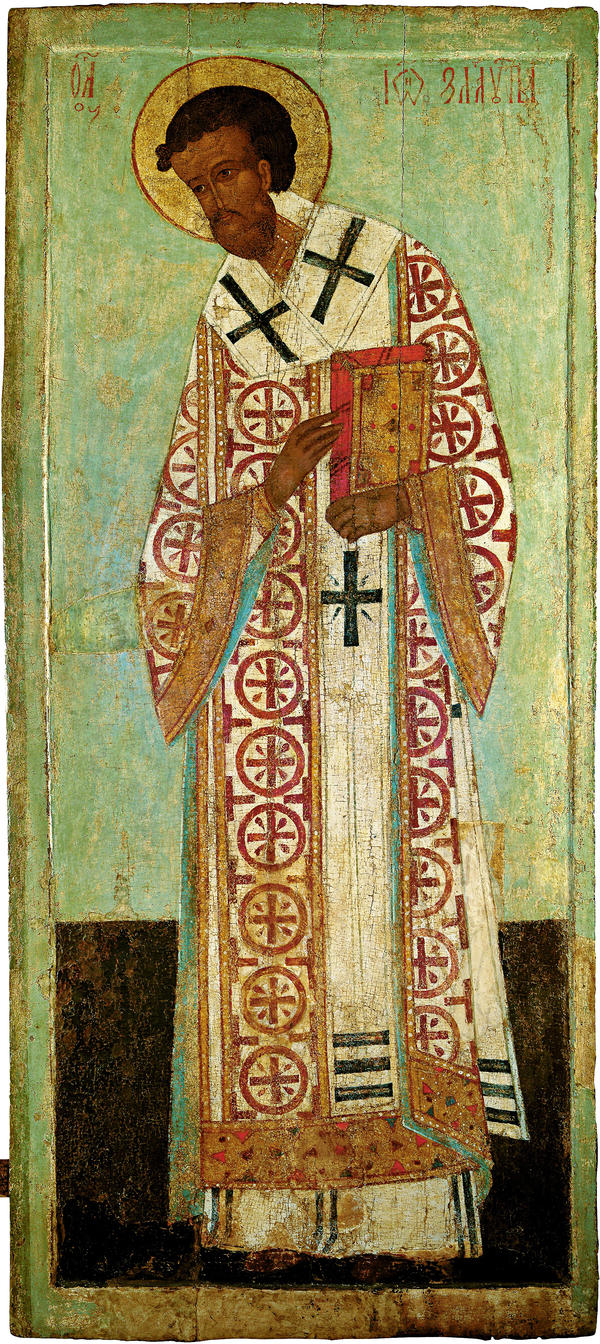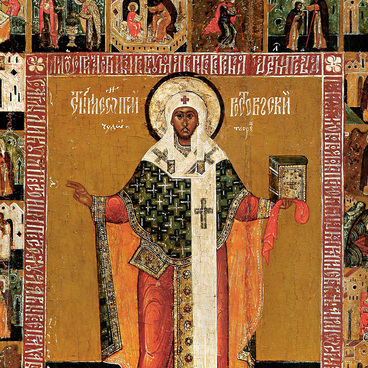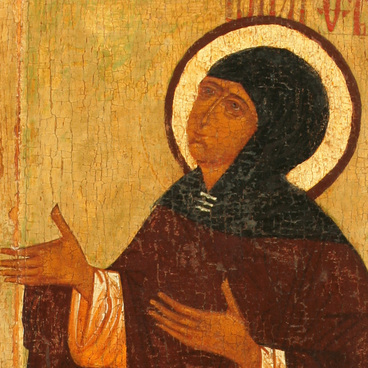The icon portraying St. John Chrysostom was painted by an unknown artist in the third quarter of the 16th century. The icon was part of the Deisis of the Saviour monastery iconostasis in Murom. The other icons of the same tier have not survived. The Deisis tier is the central row of icons in iconostasis, in which the central position is held by a picture of Christ, flanked by images of the Theotokos, John the Baptist and other saints.
Deisis icons of John Chrysostom have existed in Russia since the late 14th or early 15th century. They have been part of numerous Russian iconostases. The earliest of those that have survived is now held by the Annunciation Cathedral in the Moscow Kremlin. Traditionally, holy hierarchs’ icons, including John Chrysostom icons, are placed next to the apostles Peter and Paul. They often open up the row of icons portraying other holy bishops, like Nicholas the Wonderworker and Gregory the Theologian, and Russian saints.
St. John Chrysostom, the Archbishop of Constantinople, was born in about 350 AD in Antioch (now, Turkey). He was educated in the best schools in Antioch and was baptized at the age of 25. After his mother died, John gave all his property to the poor and took the veil. He was first ordained as a deacon and then as a priest. Before he became archbishop, he served 12 years as a priest, preaching to pagans and converting them to Christianity.
For a few years in the early 5th century, John was the Archbishop of Constantinople, but suffered persecution by Emperor Arcadius and his wife, Empress Eudoxia, who eventually exiled him to the Caucasus. St. John died on his way to the exile in 407. Thirty years after, his relics were transferred to Constantinople. John got the name Chrysostom, “golden-mouthed”, because he was a brilliant preacher, the author of numerous homilies (sermons) and interpretations of biblical books: Genesis, Matthew’s and John’s Gospels, St. Paul’s epistles. Also, John Chrysostom is known as the author of the Divine Liturgy order, which is still used in Orthodox Church services.
Deisis icons of John Chrysostom have existed in Russia since the late 14th or early 15th century. They have been part of numerous Russian iconostases. The earliest of those that have survived is now held by the Annunciation Cathedral in the Moscow Kremlin. Traditionally, holy hierarchs’ icons, including John Chrysostom icons, are placed next to the apostles Peter and Paul. They often open up the row of icons portraying other holy bishops, like Nicholas the Wonderworker and Gregory the Theologian, and Russian saints.
St. John Chrysostom, the Archbishop of Constantinople, was born in about 350 AD in Antioch (now, Turkey). He was educated in the best schools in Antioch and was baptized at the age of 25. After his mother died, John gave all his property to the poor and took the veil. He was first ordained as a deacon and then as a priest. Before he became archbishop, he served 12 years as a priest, preaching to pagans and converting them to Christianity.
For a few years in the early 5th century, John was the Archbishop of Constantinople, but suffered persecution by Emperor Arcadius and his wife, Empress Eudoxia, who eventually exiled him to the Caucasus. St. John died on his way to the exile in 407. Thirty years after, his relics were transferred to Constantinople. John got the name Chrysostom, “golden-mouthed”, because he was a brilliant preacher, the author of numerous homilies (sermons) and interpretations of biblical books: Genesis, Matthew’s and John’s Gospels, St. Paul’s epistles. Also, John Chrysostom is known as the author of the Divine Liturgy order, which is still used in Orthodox Church services.



